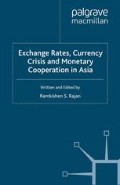Abstract
There are at least two important dimensions to the current macroeconomic imbalances plaguing the global economy. First is the rapid stockpiling of reserves by a number of Asian economies since the late 1990s. While Japan and China together account for about half of Asia’s reserve holdings (which stood at well over US$ 2,000 billion), South Korea, Taiwan, Hong Kong, India and Singapore each also hold over US$ 100 billion of reserves (Kim et al. 2005). Second is the issue of the sustainability of the US current account deficit and its resulting implications for the US dollar (Bernanke 2005).
This chapter draws on an article originally published in Asia-Pacific Journal of Economics and Business, 5 (12), 2005, 21–39 (Curtin University of Technology, Australia and Ryukoku University, Kyoto, Japan). Reprinted with permission.
Access this chapter
Tax calculation will be finalised at checkout
Purchases are for personal use only
Preview
Unable to display preview. Download preview PDF.
References
Aizenman, J. and N. Marion (2003). “The High Demand for International Reserves in the Far East: What’s Going On?,” Journal ofJapanese and International Economics, 17, 370–400.
Aizenman, J. and J. Lee (2005). “International Reserves: Precautionary Versus Mercantilist Views, Theory and Evidence,” mimeo (May).
Bernanke, B. (2005). “The Global Saving Glut and the US Current Account Deficit,” Homer Jones Lecture (St. Louis, Missouri, April 14 ).
Bird, G. (1978). The International Monetary System and the Less Developed Countries, London: Macmillan.
Bird, G. and R.S. Rajan (2002). “The Evolving Asian Financial Architecture,” Princeton Essays in International Economics No. 226, International Economics Section, Princeton University.
Bird, G. and R.S. Rajan (2003). Too Much of a Good Thing?: The Adequacy of International Reserves in the Aftermath of Crises, The Word Economy, 26, 873–891.
Clark, P. (1970). “Demand for International Reserves: A Cross-Country Analysis,” Canadian Journal of Economics, 3, 577–594.
D’Arista, J. (2000). “International Foreign Exchange Reserves: An Update,” Capital Flows Monitor, June 23, Financial Markets Center.
Dooley, M., P. Garber, and D. Mathieson (2003). “An Essay on the Revived Bretton Woods System,” Deutsche Bank Global Markets Research, September.
Dooley, M., P. Garber, and D. Mathieson (2004a). “A Map to the Revived Bretton Woods End Game: Direct Investment, Rising Real Wages and the Absorption of Excess Labor in the Periphery,” Deutsche Bank Global Markets Research, June.
Dooley, M., P. Garber, and D. Mathieson (2004b). “The Revived Bretton Woods System: Alive and Well,” Deutsche Bank Global Markets Research, December.
ICSEAD (2000). East Asian Economic Perspectives, Vol. 11, February.
Eichengreen, B. (2004). “Global Imbalances and the Lessons of Bretton Woods,” Working Paper No. 10497, NBER.
Eichengreen, B. and T. Bayoumi (1999). “Is Asia an Optimum Currency Area?, Can it Become One? Regional, Global and Historical Perspectives on Asian Monetary Relations,” in S. Collignon and J. Pisani-Ferri (eds), Exchange Rate Policies in Asian Emerging Countries, London: Routledge Press.
Eichengreen, B. and D. Mathieson (2000). “The Currency Composition of Foreign Exchange Reserves: Retrospect and Prospect,” Working Paper No. 00/131, IMF.
Fischer, S. (2001). “Opening Remarks, IMF/World Bank International Reserves: Policy Issues Forum,” Washington, DC, April 28.
Flood, R. and N. Marion (2001). “Holding International Reserves in an Era of High Capital Mobility,” Brookings Trade Forum 2001, Washington, DC: Brookings Institution.
Frankel, J. and A. Rose (2002). “An Estimate of the Effect of Common Currencies on Trade and Income,” Quarterly Journal of Economics, 117, 437–466.
Frenkel, J. and B. Jovanovic (1981). “Optimal International Reserves: A Stochastic Framework,” Economic Journal, 91, 507–541.
Glick, R. and A. Rose (2002). “Does a Currency Union Affect Trade?: The Time Series Evidence,” European Economic Review, 46, 1125–1151.
Kim, J.S., J. Li, O. Sula, R.S. Rajan and T.D. Willett (2005). “Reserve Adequacy in Asia Revisited: New Benchmarks Base on the Size and Composition of Capital Flows,” in Monetary and Exchange Rate Arrangement in East Asia, Seoul, Korea Institute for International Economic Policy.
Medhora, R. (1992a). “The West African Monetary Union: Institutional Arrangements and the Link with France,” Canadian Journal of Development Studies, 13, 409–425.
Medhora, R. (1992b). The Gain from Reserve Pooling in the West African Monetary Union, Economia Internazionale, 45, 209–222.
Rajan, R.S. (2004). “The US Current Account Deficit, Exchange Rate Flexibility and Asian Reserves,” RIS Policy Brief No. 11, New Delhi, January.
Rajan, R.S. (2005). “Asian Economic Cooperation and Integration: Sequencing of Financial, Trade and Monetary Regionalism,” in Asian Economic Cooperation and Integration: Progress, Prospects and Challenges, Manila: Asian Development Bank.
Reddy, Y.V. (2002). “India’s Foreign Exchange Reserves: Policy, Status and Issues,” lecture at the National Council of Applied Economic Research, New Delhi, May 10.
Rose, A. (2000). “One Money, One Market: Estimating the Effect of Common Currencies on Trade,” Economic Policy, 15, 7–46.
Willett, T.D. (2001). “International Financial Markets as Sources of Crisis or Discipline: The Too Much, Too Late Hypothesis,” Essays in International Finance No. 208, International Economics Section, Princeton University.
Williams, O., T. Pollius, and S. Hazel (2001). “Reserve Pooling in the Eastern Caribbean Currency Union and the CFA Franc Zone: A Comparative Analysis,” Working Paper No. 01/104, IMF.
Editor information
Editors and Affiliations
Copyright information
© 2009 Reza Siregar, Graham Bird
About this chapter
Cite this chapter
Siregar, R., Bird, G. (2009). Examining the Case for an Asian Reserve Pool. In: Rajan, R.S. (eds) Exchange Rates, Currency Crisis and Monetary Cooperation in Asia. Palgrave Macmillan, London. https://doi.org/10.1057/9780230234192_9
Download citation
DOI: https://doi.org/10.1057/9780230234192_9
Publisher Name: Palgrave Macmillan, London
Print ISBN: 978-1-349-36691-0
Online ISBN: 978-0-230-23419-2
eBook Packages: Palgrave Economics & Finance CollectionEconomics and Finance (R0)

